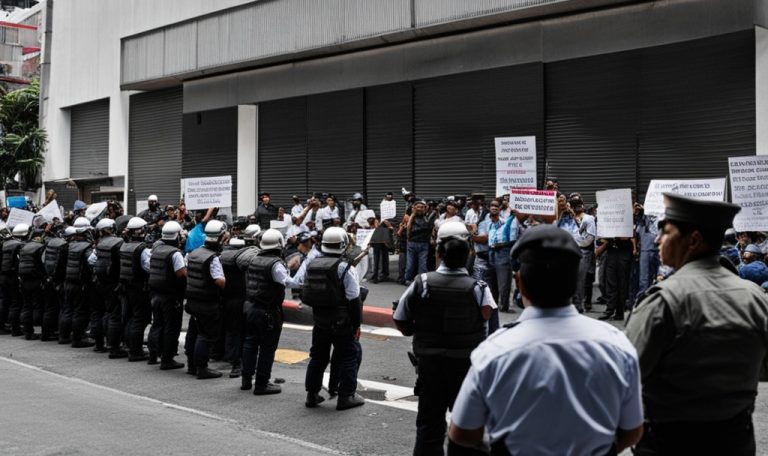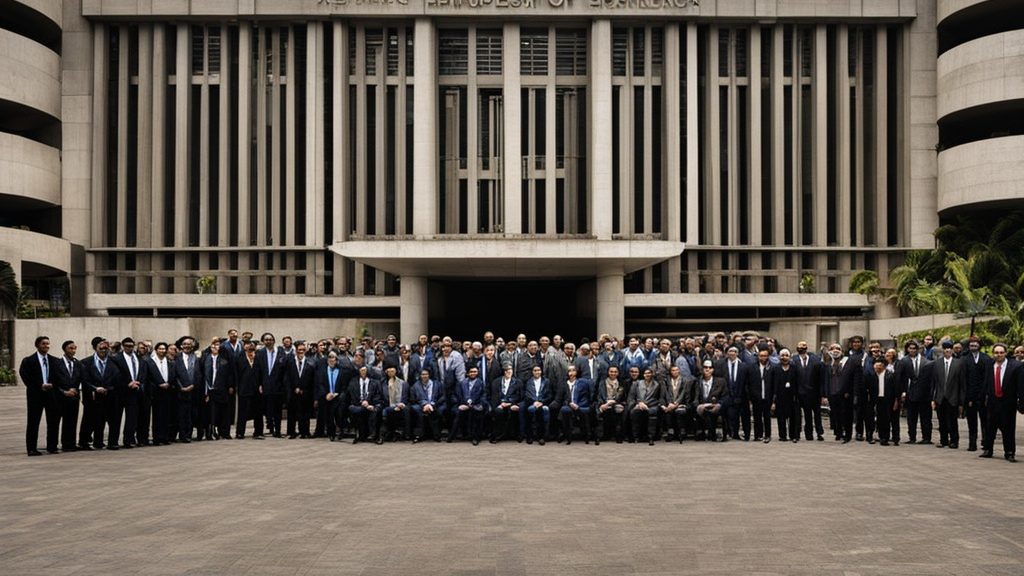The Central Bank of Costa Rica (BCCR) is facing off with the country’s industrial sectors. These sectors are pushing for changes to help make Costa Rica’s economy stronger. They want the exchange rate of the dollar to be ¢620, quicker drop of the Monetary Policy Rate (TPM), and also to keep the national currency’s value steady. But, the BCCR’s Board of Directors has said no to these demands.
The BCCR is firm in its approach. It is trying to deal with high inflation while promoting economic growth and keeping the currency stable. Its choices affect many, from manufacturers to farmers and other businesses. Everyone is watching closely to see what happens next.
Key Takeaways
- The Central Bank of Costa Rica (BCCR) has rejected demands from industrial sectors to adjust the exchange rate, lower interest rates, and maintain currency stability.
- The BCCR is focused on its mandate to curb inflation and promote financial stability, despite concerns from the private sector.
- The decision has sparked uncertainty and concerns among businesses and workers, with some announcing layoffs and company closures.
- The agricultural sector has also voiced worries about the potential impact on their competitiveness and jobs.
- The BCCR remains steadfast in its monetary policy stance, balancing economic priorities and upholding its legal mandate.
Industrial Sectors’ Demands Rebuffed by Costa Rica’s Central Bank
The Central Bank of Costa Rica (BCCR) has said no to the country’s industrial sectors. They asked for help keeping the national currency’s stability, both inside and outside the country. The BCCR stated they’re already doing this. It’s their duty under their Organic Law, and they do it fairly for all.
Exchange Rate Adjustment Calls Dismissed
Asked to fix the exchange rate, the BCCR explained something important. They said there’s no fixed real exchange rate that fits all. They also pointed out that not even under law or by what makes sense, can they promise a decrease in value each year.
Requests for Lower Interest Rates Denied
About lowering the rate from 4.75% to 3.5%, the BCCR rejected the idea. They said they have been slowly decreasing this rate since March 2023. Their aim is to lower inflation to a stable level.

Central Bank of Costa Rica Rejects Industrial Sectors’ Economic Demands
The Central Bank of Costa Rica’s (BCCR) Board of Directors said no to the country’s industries. They underline following the internal and external stability of the national currency, fairly and without favoritism.
The BCCR resisted the industrial and agricultural groups’ requests. These include asking for a exchange rate change and lower interest rates. The bank sticks to its monetary policy plan.
BCCR argues there’s no such thing as a ‘neutral real exchange rate.’ It can’t promise a yearly currency devaluation. They stated a proposed Monetary Policy Rate cut from 4.75% to 3.5% won’t happen.
The bank is focused on financial stability. It wants to fight inflation and help economic growth in Costa Rica. Even with sectors’ concerns, the BCCR is firm in its answer.

Monetary Policy Stance Aimed at Curbing Inflation
The Central Bank of Costa Rica (BCCR) is working hard to fight inflation. They have been cutting the Monetary Policy Rate (TPM) since March 2023. The goal is to bring inflation down to a good level.
Repeated Interest Rate Cuts to Rein in Price Pressures
“These cuts bring us closer to a normal state,” said the bank. They explained that changes in policy don’t work right away. It takes time for the effects to show in the costa rican economy.”
Transmission of Policy Changes Takes Time
The BCCR knows their actions don’t instantly affect inflation or economic growth. “We aim to keep financial stability and a strong currency exchange. Lowering rates is our way to fight price pressures. Our goal is to guide the manufacturing sector to a better future,” they stated.
Maintaining Financial Stability and Currency Strength
The Central Bank of Costa Rica (BCCR) is dedicated to keeping the local currency strong, both at home and internationally. This goal is set by the law that created it. As the main body overseeing money matters in the country, the BCCR commits to ensuring the economy stays robust.
Legal Mandate to Uphold Internal and External Currency Stability
Responding to needs of different business areas, the BCCR states it sticks to its job of keeping the money stable. It doesn’t favor one group over another. Its work is all about the whole country’s financial health and growth.
Keeping the currency steady is key to the BCCR’s wider plan to manage money well. This includes keeping prices stable, helping the economy grow, and keeping the country financially strong. Doing this helps everyone in Costa Rica.
Abandoning Crawling Peg Exchange Rate Regime
The Central Bank of Costa Rica (BCCR) noted a key change in 2006. Costa Rica moved away from using the crawling peg system. This system used to create ongoing inflation and needed constant tweaks to fit changing economic conditions. By changing its monetary policy, Costa Rica made a big shift from its old ways of handling currency exchange.
Shift from Inflationary Crawling Peg in 2006
In the years before 2006, Costa Rica stuck to a crawling peg system. It slowly devalued the Costa Rican colón against the US dollar. The aim was to control the pace but it led to rising prices across the manufacturing sector and the wider economy, causing inflation.
No Guaranteed Annual Devaluation Trend
The BCCR pointed out something important. There’s no sure way to define a “neutral real exchange rate.” It’s not possible to promise a certain level of devaluation each year. This info ignores calls from industries to set a steady devaluation rate. It shows the bank’s focus on financial stability and its monetary policy goals over meeting specific economic needs.
Private Sector Concerns and Job Losses
The Central Bank of Costa Rica (BCCR) decisions worry many. Leaders in manufacturing and farming fear the Central Bank’s choices are making things unsure for their people and companies.
Uncertainty Grows Among Workers and Businesses
Oscar Arias Moreira, acting head of the National Chamber of Agriculture and Agro-industry, highlighted the issue. He noted that many workers are worried. With recent layoffs and company shutdowns, lots of families are struggling to meet their needs.
Layoffs and Company Closures Announced
The BCCR dismissed calls for changes to economic policies. This led to more worries in the private sector. Companies in farming and manufacturing have seen layoffs and shutdowns. This has added to the stress for workers and their families.
Agricultural Sector Voices Worries
The Central Bank of Costa Rica’s policies are sparking debate. The agricultural sector is worried, too. The National Chamber of Agriculture and Agro-industry (CNAA) has been warning the Central Bank. They’re worried about how the exchange rate’s behavior might hurt agriculture. This could affect around 500,000 jobs.
Potential Adverse Effects on Competitiveness
The CNAA points out how important the agricultural sector is to the Costa Rican economy. They fear that current challenges might make it hard to compete. The organization is working hard to show the Central Bank’s monetary policy could really harm them. They want the sector to stay strong and productive.
Warnings from National Chamber of Agriculture and Agro-industry
Oscar Arias Moreira heads the CNAA and he’s very worried. He says the Central Bank’s actions are making things uncertain for private sector workers, especially farmers. “The Central Bank’s stance is only adding to the worries of many. We’re already seeing some people losing their jobs and companies closing. This means hundreds of Costa Rican families are struggling to meet their basic needs,” he warned.
Productive Sectors Push for Reforms
There’s a debate happening between the Central Bank of Costa Rica (BCCR) and the country’s industrial sectors. The labor and business sectors feel change is needed to safeguard jobs and stay competitive. They are concerned about issues like monetary policy, interest rates, and the value of the Costa Rican currency.
Call for Measures to Protect Jobs and Competitiveness
The private sector’s reps, especially those from manufacturing and farming, are worried. They fear the BCCR’s decisions might hurt their ability to work. They say the bank’s refusal to act is making things uncertain and rocky. This could potentially cause job cuts and harm the national economy’s competitiveness.
Oscar Arias Moreira steps in for the National Chamber of Agriculture and Agro-industry (CNAA). He wants the BCCR to pay attention to the sectors’ worries. “The Central Bank’s stand makes thousands of workers anxious,” he points out. He highlights that companies are already closing, touching the lives of many families.
The CNAA has been warning about the exchange rates for months now. They worry about the effects on the agriculture sector, responsible for almost half a million jobs. This might not be good for the sector’s workers and their communities.
The productive sectors are pushing hard for the BCCR to change. They believe better monetary and exchange rate plans could help. They think reasonably adjusted policies might ease difficulties for various industries. This could uplift the national economy over time.
Central Bank’s Stance Remains Firm
The Central Bank of Costa Rica stands its ground despite private sector concerns. It refuses the industrial sectors’ requests. The bank stays strong in its commitment to monetary policy and currency stability. This is even though some in the Costa Rican economy are worried.
The central bank says it must keep the national currency stable. It sees this as its serious duty, not favoring anyone. This has led to arguments with the manufacturing sector and agricultural producers. They want the exchange rate and interest rates adjusted. They believe these changes would help their businesses grow.
Yet, the Central Bank of Costa Rica has denied these requests. It says it’s hard to manage inflation, economic growth, and financial stability all at once. It highlights the steps it’s taking, like lowering interest rates. These moves are to ease inflation over time.
The Central Bank keeps its position strong as discussions go on. It’s focused on meeting its legal duties and goals to protect Costa Rica’s economy. Saying no to the industrial sectors has made some worry. But the bank is determined to stick to its goals. This is to help make sure Costa Rica sees financial stability and economic growth.
Balancing Economic Priorities and Policy Objectives
The Central Bank of Costa Rica manages a mix of economic needs like controlling inflation, boosting growth, and keeping the national currency stable. To do this, it sets policies that deal with these tough issues. These policies are based on a mandate to make sure the national and foreign currencies stay stable.
Navigating Inflation, Growth, and Currency Stability
Keeping inflation in check is the bank’s top goal. It has cut the TPM rate many times since March 2023 to help. But, changing policies can take a while to show results in the economy.
The bank also looks at the bigger picture, aiming to support sustainable growth and keep the currency strong. This means juggling the needs of different sectors, like manufacturing and agriculture, carefully. It also works to keep Costa Rica’s economy stable.
Some in the industry want the bank to be more forceful in solving problems. Yet, the Central Bank sticks to its approach, seeing the value of keeping a balanced and sustainable economic policy.
Impact on Costa Rica’s Economic Landscape
The Central Bank’s rejection affects many in Costa Rica’s economy. It worries manufacturers and agricultural producers. These groups fear for their competitiveness and job security. The bank’s stance hits the wider Costa Rican economic landscape, influencing monetary policy and currency stability.
Implications for Different Sectors and Stakeholders
The manufacturing sector is deeply worried by the Central Bank’s decision. Oscar Arias Moreira, from the National Chamber of Agriculture and Agro-industry (CNAA), said it just spikes “uncertainty for thousands of workers.” He pointed out that layoffs and company closures are already happening.
The agricultural sector shares this concern. The CNAA alerted the Central Bank about adverse effects on the industry months ago. This industry supports around 500,000 direct and indirect jobs.
The productive sectors push for reforms to defend competitiveness and jobs. But, the Central Bank’s stance is steady. It says it must ensure internal and external currency stability.
The Central Bank’s choice will have a wide impact. The manufacturing, agricultural, and other productive sectors face big challenges. They’re fighting to keep their competitiveness and jobs.
Conclusion
In the Central Bank of Costa Rica’s monetary policy debate, the bank rejects industrial sectors’ demands. It focuses on lowering inflation and keeping the economy stable. This stance affects Costa Rica’s economic future.
Stakeholders like manufacturers and farmers want changes to save jobs and stay competitive. The policy’s effects touch various economic areas. These include manufacturing and agriculture, dealing with inflation and currency issues.
The Central Bank of Costa Rica defends its position strongly against industrial pressures. It does so for legal reasons and to boost the country’s economy over time. This decision will keep influencing Costa Rica’s economic path for the foreseeable future.



